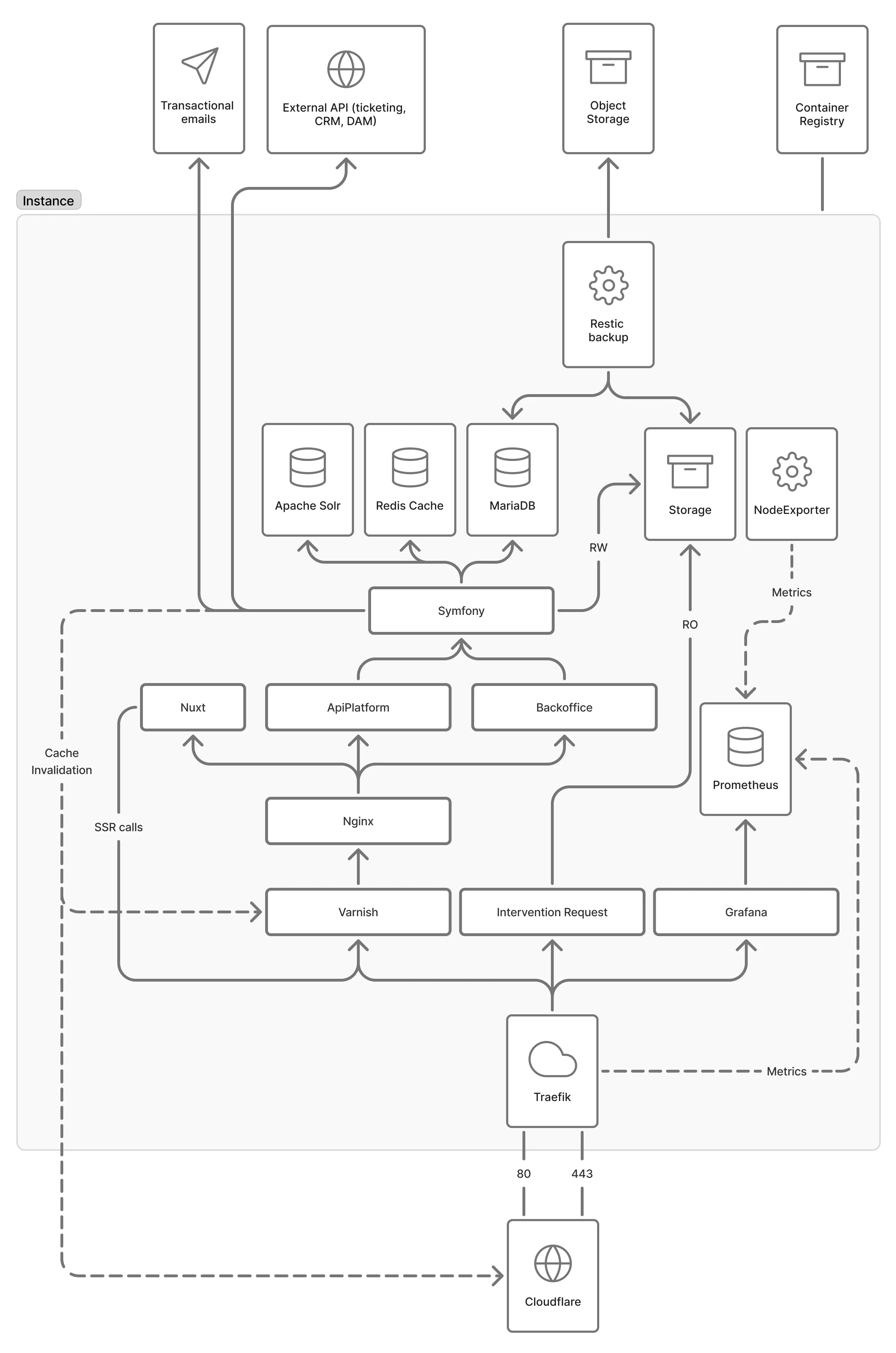Hosting infrastructure example
This is an example on how you can provide a complete technical architecture for your Roadiz website, highlighting the key components, data flows, and interactions between various services.

Overview of the Infrastructure
The architecture is designed with modularity, high availability, scalability, and performance in mind. It consists of multiple layers, including caching, backend, storage, and monitoring. And this relies on containerized applications which applies for Docker, Docker Compose or even Kubernetes.
Key Technologies Used:
- (optional) Traefik for reverse proxy and traffic routing.
- (optional) Cloudflare for DDoS protection, traffic optimization, and caching.
- (optional) Varnish for HTTP request caching to improve performance.
- Nginx as the web server and proxy.
- Symfony as the backend framework.
- Nuxt.js for frontend with SSR (Server-Side Rendering). We use Nuxt for example but you can use another front-end.
- MariaDB/MySql as the relational database.
- (optional) Redis for session and object caching.
- (optional) Apache Solr for indexing and advanced search.
- (optional) Prometheus & Grafana for performance monitoring and visualization.
Request Flow and Logical Architecture
Handling Incoming Requests
- User requests arrive via Cloudflare, which acts as a CDN and web application firewall (WAF).
- Traefik accepts traffic on ports 80 and 443 and route it to internal services.
- Varnish caches frequently accessed pages to enhance performance and reduce server load.
- Nginx serves as a gateway between backend services and the frontend.
Backend and Data Processing
Symfony serves as the core backend engine and interacts with:
- MariaDB for structured data storage.
- Redis for fast session and object caching.
- Apache Solr for indexing and search functionality.
ApiPlatform exposes REST APIs used by the frontend and external services.
Roadiz Backoffice provides an administrative interface for content and user management.
Caching Flow and Invalidation
Caching Layers
The infrastructure relies on multiple caching layers to improve performance:
- Varnish caches full HTTP and API responses to accelerate content delivery.
- Redis stores session and specific database data. It can be useful to store temporary business cache and external API data.
- Cloudflare caches static assets and pages at the edge network.
Cache Invalidation Mechanisms
Cache invalidation ensures that users receive up-to-date content without unnecessary database queries. The process includes:
Varnish Cache Invalidation
- When content is updated in the database, Symfony triggers a PURGE request to Varnish.
- Varnish clears the relevant cached objects and fetches fresh content from the backend.
Redis Cache Invalidation
- Expiry times (TTL) are set for session data and dynamic queries.
- When data is modified, Symfony automatically removes the corresponding Redis keys.
Cloudflare Cache Purging
- Cloudflare cache can be manually or automatically purged via API when significant updates occur.
- URL-based purging ensures that only modified content is refreshed.
Storage and Backup Management
- Restic Backup manages automated backups of databases and files to distant S3 Object Storage.
- Critical data (logs, media files) is stored persistently in a secure Storage system.
Monitoring and Observability
- NodeExporter collects server metrics and sends them to Prometheus.
- Prometheus stores and processes performance metrics, enabling anomaly detection.
- Grafana provides real-time visualization dashboards for system monitoring.
External Integrations
- Transactional Emails for notifications and user interactions.
- External APIs for ticketing, CRM, and DAM (Digital Asset Management).
- Container Registry for managing and deploying containerized services.
Security and Scalability
- Cloudflare protects against DDoS attacks and optimizes caching.
- Traefik and Nginx efficiently distribute incoming traffic.
- Redis & Varnish enhance response speed by reducing direct database queries.
- Restic Backup ensures data recovery in case of failure.
